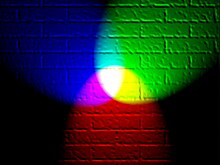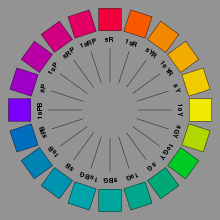
|
WS2812B RGB Full Color LED Light Bar(black/60 lamps/meter) |
x 144 | |

|
10uF Capacitor |
x 1 | |

|
Resistor 220 0603YAGEO
|
x 1 | |

|
10nF / 22pF Ceramic |
x 1 | |

|
MF-R250-0-10Bourns
|
x 1 |

|
arduino IDEArduino
|
WS2812B Rgb Shades
Red (RGB)[edit]

Red, green and blue lights, representing the three basic additive primary colors of the RGB color system, red, green, and blue
Color coordinatesHex triplet#FF0000sRGBB (r, g, b)(255, 0, 0)HSV (h, s, v)(0°, 100%, 100%)CIELChuv (L, C, h)(53, 179, 12°)SourceHTML/CSS[3]ISCC–NBS descriptorVivid reddish orangeB: Normalized to [0–255] (byte)
The color displayed at right, red (RGB), RGB red, or electric red[citation needed] (as opposed to pigment red, shown below) is the brightest possible red that can be reproduced on a computer monitor. This color is an approximation of an orangish red spectral color. It is one of the three primary colors of light in the RGB color model, along with green and blue. The three additive primaries in the RGB color system are the three colors of light chosen such as to provide the maximum gamut of colors that are capable of being represented on a computer or television set, at a reasonable expense of power. Portable devices such as mobile phones might have an even narrower gamut due to this purity–power tradeoff and their "red" may be less colorful and more orangish than the standard red of sRGB.
This color is also the color called red in the X11 web colors, which were originally formulated in 1987. It is also called color wheel red. It is at precisely zero (360) degrees on the HSV color wheel, also known as the RGB color wheel (Image of RGB color wheel). Its complementary color is cyan.
Red (CMYK) (pigment red)

Cyan, magenta, and yellow are the three subtractive primary colors used in printing
Color coordinatesHex triplet#ED1B24sRGBB (r, g, b)(237, 27, 36)HSV (h, s, v)(357°, 89%, 93%)CIELChuv (L, C, h)(51, 157, 12°)SourceCMYKISCC–NBS descriptorVivid reddish orangeB: Normalized to [0–255] (byte)
Pigment red is the color red that is achieved by mixing process (printer's) magenta and process (printer's) yellow in equal proportions. This is the color red that is shown in the diagram located at the bottom of the following website offering tintbooks for CMYK printing: [1].
The purpose of the CMYK color system is to provide the maximum possible gamut of colors capable of being reproduced in printing.
Psychedelic art made people used to brighter colors of red, and pigment colors or colored pencils called "true red" are produced by mixing pigment red with a tiny amount of white. The result approximates (with much less brightness than is possible on a computer screen) the electric red shown above.
Red (Crayola)
Color coordinatesHex triplet#ED0A3FsRGBB (r, g, b)(237, 10, 63)HSV (h, s, v)(346°, 96%, 93%)CIELChuv (L, C, h)(50, 153, 8°)SourceCrayolaISCC–NBS descriptorVivid redB: Normalized to [0–255] (byte)
The color defined as red in Crayola crayons is displayed at right.
Red was one of the original colors formulated by Crayola in 1903.
Red (Munsell)

The hues of the Munsell color system, at varying values, and maximum chroma to stay in the sRGB gamut
Color coordinatesHex triplet#F2003CsRGBB (r, g, b)(242, 0, 60)HSV (h, s, v)(345°, 100%, 95%)CIELChuv (L, C, h)(51, 159, 8°)SourceMunsell Color WheelISCC–NBS descriptorVivid redB: Normalized to [0–255] (byte)
The color defined as red in the Munsell color system (Munsell 5R) is shown at right. The Munsell color system is a color space that specifies colors based on three color dimensions: hue, value (lightness), and chroma (color purity), spaced uniformly in three dimensions in the elongated oval at an angle shaped Munsell color solid according to the logarithmic scale which governs human perception. In order for all the colors to be spaced uniformly, it was found necessary to use a color wheel with five primary colors—red, yellow, green, blue, and purple.
The Munsell colors displayed are only approximate as they have been adjusted to fit into the sRGB gamut.
Red (NCS) (psychological primary red)

Approximations within the sRGB gamut to the primary colors of the Natural Color System, a model based on the opponent process theory of color vision
Color coordinatesHex triplet#C40234sRGBB (r, g, b)(196, 2, 52)HSV (h, s, v)(345°, 99%, 77%)CIELChuv (L, C, h)(41, 127, 8°)SourcesRGB approximation to NCS S 1080-R[4]ISCC–NBS descriptorVivid redB: Normalized to [0–255] (byte)
The color defined as red in the NCS or Natural Color System is shown at right (NCS 1080-R). The Natural Color System is a color system based on the four unique hues or psychological primary colors red, yellow, green, and blue. The NCS is based on the opponent process theory of vision.
The Natural Color System is widely used in Scandinavia.
RGB LED Schematic
There are actually two types of RGB led’s; the common cathode one and the common anode one. In the common cathode RGB led, the cathode of all the led’s is common and we give PWM signals to the anode of led’s while in the common anode RGB led, the anode of all the led’s is common and we give PWM signals to the cathode of led’s.

The one that we are going to use is the common cathode RGB led. So, we will connect the common pin to the GND of Arduino and the other three leads of the led’s to the PWM pins of Arduino.
Note
You cannot distinguish between the common cathode and common anode type by just looking at the RGB led because both look same. You will have to make the connections to see that either it is common cathode or common anode.
The RGB led has one big lead than the other leads. In the common cathode case, it will be connected to GND and in the common anode case; it will be connected to 5V.
Arduino RGB LED Circuit Diagram
Connect the cathode of the RGB led which is the longer pin of RGB led to the GND of Arduino and the other three pins to the pin 11, 10, 9 of Arduino through the 220 ohm resistors. The resistors will prevent the excess amount of current to flow through the RGB led.
If you are using the common anode RGB led, then connect the long lead to the 5V of Arduino.
Note
If you have any other Arduino, then make sure that you are using the PWM pins of that Arduino. The PWM pins have a ~ sign with them.
Working
Inside the RGB led, there are three more led’s. So by changing the brightness of these led’s, we can obtain many other colors. To change brightness of RGB led, we can use the PWM pins of Arduino. The PWM pins will give signal different duty cycles to the RGB led to obtain different colors.
The below RGB color wheel will help you in selecting different colors for Arduino RGB led.
Overview
In LED strips world, there are (so) many models.
As explained on Wikipedia... "The most common design differences are in how individual LEDs are controlled, specifically differences in color and whether or not each LED is addressable.
Single Color, non-addressable: Every LED on the strand is a single white colour, typically ranging from 2700K to 6500K in colour temperature, or any of several monochrome colors covering the range of the visible spectrum (generally from 400-700 nanometers in wavelength).
Multicolor, non addressable: Each LED is capable of displaying red, green, blue, or all three (white), driven by three input power rails. All the LEDs display the same colour at any one time, but the colour can be manipulated by varying the voltage applied to each of the three power inputs.
RGB, addressable: Multiple colours and addresses. Each LED has its own chip meaning they can be individually triggered for chasing, strobing, and colour changing"
As a generic rule of thumb, you can consider that "cheap RGB LED strip" = "non addressable". There are numerous tutorials on addressable LED strips but not that much on simple, non addressable ones.
LED Strip
Here is how my LED strip looks like. The strip is divided into segments, each segment hosting 3 RGB LEDs:

A segment

Connections between segments
Here is how my LED strip is wired, internally:

Some models share a common POSITIVE, other shares a common NEGATIVE. My LED strip is as per the following:

Input Voltage
The next topic to consider is .... input voltage. LED strip lights most commonly operate on 12 or 24 volts DC from a power supply. Mine was 12 VDC. Depending on the strip length, you should pay attention to current as well and select a power supply that can handle LED strip current requirements.
If you just want to turn LED strip on/off (as a whole or per color), relays are okay and easy to setup but if you want to control intensity as well (dimming), then MOSFETs are a great solution.
In order to control colors (and intensity), I need to control A1, A2 and A3. The LED strip requires 12 VDC feed and, even if you had a 5 VDC LED strip, it would require to much current to be controlled directly, that's why I need some kind of circuit based on transistors.
Control Circuit
Here is how my control circuit looks like (duplicate it 3 times, one for each color):

WS2812B Rgb Shades
*PCBWay community is a sharing platform. We are not responsible for any design issues and parameter issues (board thickness, surface finish, etc.) you choose.
- Comments(0)
- Likes(0)
- 0 USER VOTES
- YOUR VOTE 0.00 0.00
- 1
- 2
- 3
- 4
- 5
- 6
- 7
- 8
- 9
- 10
- 1
- 2
- 3
- 4
- 5
- 6
- 7
- 8
- 9
- 10
- 1
- 2
- 3
- 4
- 5
- 6
- 7
- 8
- 9
- 10
- 1
- 2
- 3
- 4
- 5
- 6
- 7
- 8
- 9
- 10
 More by Sreeram.zeno
More by Sreeram.zeno
-
 Esp12-F Cluster V1.0
The ESP8266 is a low-cost Wi-Fi microchip, with built-in TCP/IP networking software, and microcontro...
Esp12-F Cluster V1.0
The ESP8266 is a low-cost Wi-Fi microchip, with built-in TCP/IP networking software, and microcontro...
-
 TB6612FNG Motor Driver
The TB6612FNG Motor Driver can control up to two DC motors at a constant current of 1.2A (3.2A peak)...
TB6612FNG Motor Driver
The TB6612FNG Motor Driver can control up to two DC motors at a constant current of 1.2A (3.2A peak)...
-
 Sunny Buddy Solar Charger v1.0
This is the Sunny Buddy, a maximum power point tracking (MPPT) solar charger for single-cell LiPo ba...
Sunny Buddy Solar Charger v1.0
This is the Sunny Buddy, a maximum power point tracking (MPPT) solar charger for single-cell LiPo ba...
-
 Diy 74HC4051 8 Channel Mux Breakout Pcb
The 74HC4051; 74HCT4051 is a single-pole octal-throw analog switch (SP8T) suitable for use in analog...
Diy 74HC4051 8 Channel Mux Breakout Pcb
The 74HC4051; 74HCT4051 is a single-pole octal-throw analog switch (SP8T) suitable for use in analog...
-
 Diy RFM97CW Breakout Pcb
IntroductionLoRa? (standing for Long Range) is a LPWAN technology, characterized by a long range ass...
Diy RFM97CW Breakout Pcb
IntroductionLoRa? (standing for Long Range) is a LPWAN technology, characterized by a long range ass...
-
 ProMicro-RP2040 Pcb
The RP2040 is a 32-bit dual ARM Cortex-M0+ microcontroller integrated circuit by Raspberry Pi Founda...
ProMicro-RP2040 Pcb
The RP2040 is a 32-bit dual ARM Cortex-M0+ microcontroller integrated circuit by Raspberry Pi Founda...
-
 Serial Basic CH340G Pcb
A USB adapter is a type of protocol converter that is used for converting USB data signals to and fr...
Serial Basic CH340G Pcb
A USB adapter is a type of protocol converter that is used for converting USB data signals to and fr...
-
 Mp3 Shield For Arduino
Hardware OverviewThe centerpiece of the MP3 Player Shield is a VS1053B Audio Codec IC. The VS1053B i...
Mp3 Shield For Arduino
Hardware OverviewThe centerpiece of the MP3 Player Shield is a VS1053B Audio Codec IC. The VS1053B i...
-
 MRK CAN Shield Arduino
The CAN-BUS Shield provides your Arduino or Redboard with CAN-BUS capabilities and allows you to hac...
MRK CAN Shield Arduino
The CAN-BUS Shield provides your Arduino or Redboard with CAN-BUS capabilities and allows you to hac...
-
 AVR ISP Programmer
AVR is a family of microcontrollers developed since 1996 by Atmel, acquired by Microchip Technology ...
AVR ISP Programmer
AVR is a family of microcontrollers developed since 1996 by Atmel, acquired by Microchip Technology ...
-
 Diy Arduino mega Pcb
The Arduino Mega 2560 is a microcontroller board based on the ATmega2560. It has 54 digital input/ou...
Diy Arduino mega Pcb
The Arduino Mega 2560 is a microcontroller board based on the ATmega2560. It has 54 digital input/ou...
-
 Max3232 Breakout Board
MAX3232 IC is extensively used for serial communication in between Microcontroller and a computer fo...
Max3232 Breakout Board
MAX3232 IC is extensively used for serial communication in between Microcontroller and a computer fo...
-
 Line Follower Pcb
The Line Follower Array is a long board consisting of eight IR sensors that have been configured to ...
Line Follower Pcb
The Line Follower Array is a long board consisting of eight IR sensors that have been configured to ...
-
 HMC6343 Accelerometer Module
The HMC6343 is a solid-state compass module with tilt compensation from Honeywell. The HMC6343 has t...
HMC6343 Accelerometer Module
The HMC6343 is a solid-state compass module with tilt compensation from Honeywell. The HMC6343 has t...
-
 RTK2 GPS Module For Arduino
USBThe USB C connector makes it easy to connect the ZED-F9P to u-center for configuration and quick ...
RTK2 GPS Module For Arduino
USBThe USB C connector makes it easy to connect the ZED-F9P to u-center for configuration and quick ...
-
 Arduino Explora Pcb
The Arduino Esplora is a microcontroller board derived from the Arduino Leonardo. The Esplora differ...
Arduino Explora Pcb
The Arduino Esplora is a microcontroller board derived from the Arduino Leonardo. The Esplora differ...
-
 Diy Stepper Motor Easy Driver
A motor controller is a device or group of devices that can coordinate in a predetermined manner the...
Diy Stepper Motor Easy Driver
A motor controller is a device or group of devices that can coordinate in a predetermined manner the...
-
 Diy Arduino Pro Mini
The Arduino Pro Mini is a microcontroller board based on the ATmega168 . It has 14 digital input/out...
Diy Arduino Pro Mini
The Arduino Pro Mini is a microcontroller board based on the ATmega168 . It has 14 digital input/out...
-
-
TEKTRONIX THS710,THS720,THS730 External Battery Charger with 3D Printed Case
53 1 0 -














































